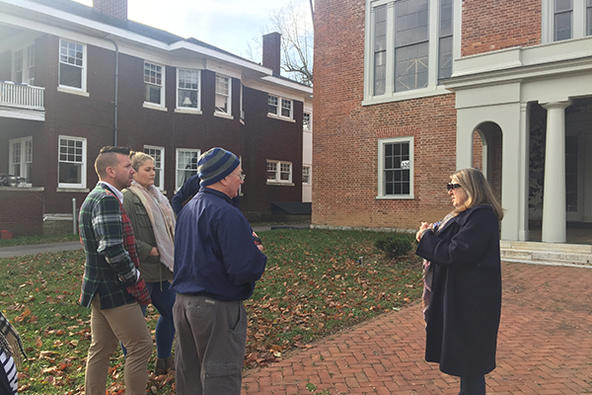Historic Preservation Professor Secures Pope Villa Spot on National Register

Julie Riesenweber, assistant professor in the Department of Historic Preservation in the University of Kentucky College of Design, recently helped Lexington's Pope Villa achieve its place on the National Register of Historic Places as a nationally significant example of early national-era architecture. The National Register is the nation’s official list of historic and archaeological resources deemed worthy of preservation, a program of the National Park Service.
“We preserve so that we don’t forget, and we should be grateful for historians who remind us to care. The achievement is a testament to Julie’s tenacity and scholarly acumen in her steadfast work on Pope Villa," said Dean Mitzi Vernon. "Its placement on the National Register validates the continued significance of preservation research.”
Located at 326 Grosvenor Ave., Pope Villa was designed by Benjamin Henry Latrobe and built by local artisans in 1812 for U.S. Sen. John Pope and his second wife, Eliza Pope. Latrobe (1764-1820) emigrated from England 1796 and became one of America’s first professional architects. In 1803, President Thomas Jefferson appointed him surveyor of public buildings of the United States, and to work as superintendent of construction of the United States Capitol.
While Latrobe is best known for his public buildings, he also designed more than 60 residences throughout the country. Pope Villa is one of only three still standing today and the only suburban villa.
Riesenweber’s supporting research and authorship of the National Register nomination resulted in the listing of the property; two previous attempts to list the building individually were unsuccessful, primarily because they focused exclusively on Latrobe's original design, overlooking the significant alterations of the 1840s, 1860s and the early 20th century.
“After the previous failed attempts, I realized the need to capture Pope Villa’s entire period of significance to 1843, which included Captain Henry and Elizabeth Johnson’s renovations,” explained Riesenweber. “These changes brought the house’s plan into conformity with local expectations, creating ‘a product of a nationally significant architect who was subject to local interpretation by its builders and by its users … revealing [the] democratization of the design process on one significant building’ as stated in the nomination.”
She also argued that with further study, it has the potential to convey important information about the interaction between trained designers like Latrobe, and traditional designer/builders during America's early National Period, at a time when architecture was just beginning to emerge as a profession.
Credits
Text by Julie Wilson (UK Public Relations & Marketing).

